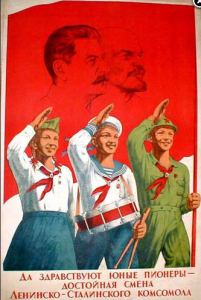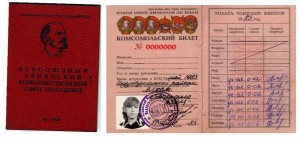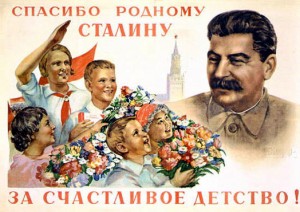“…We need that generation of young people who began to reach political maturity in the midst of a disciplined and desperate struggle against the bourgeoisie. In this struggle that generation is training genuine Communists; it must subordinate to this struggle, and link up with it, each step in its studies, education, and training.”
-V.I. Lenin, Tasks of the Youth Leagues (Bourgeois and Communist Morality)
Long Live Young Pioneers -- the worthy replacements for the Leninist-Stalinist Komsomol (Source: New Gallery. 2000.)
Introduction:
Children in the Soviet Union held a special place in the hearts of citizens and the Party. They represented not only the innocence of youth, but also the promise of the socialist future; in order for the international Marxist Revolution to succeed, the youth had to be treated well and educated politically. Communist authorities took many routes to achieve this goal. Primarily, the Communist Party fostered a cult of childhood, much like Stalin’s cult of personality, which idealized Soviet childhood. The Communist Party formalized this cult through youth organizations such as the Komsomol, Young Pioneers, and Little Octobrists.
Much as Lenin did in his 1920 speech to the Komsomol, this cult relied on a juxtaposition between “true” Communist children and everyone else. By institutionalizing this reverence for childhood, the Communist Party isolated those children who did not join such groups, and were in fact able to create a radical other, or class enemy, before citizens even entered the workforce. The force of this institutionalization was seen most strongly in the formative years of the Soviet Union, and was perfected under Stalin. The effect these groups had is undeniable; the Communists created secondary communities for children to align themselves with. Rather than attach themselves most strongly to their families, Soviet children were taught to prioritize Communism above all, and these youth organizations provided the very first encounters with socialism. This had the significant effect of diminishing the role of the family structure, and these groups became the primary outlet for self-expression among Soviet children. To carry the identity card of the Komsomol was to declare oneself a loyal Communist.
This guided history will attempt to identify different aspects which contributed to the development of the Soviet cult of childhood, from the organization of youth groups, to childhood education, as well as the role of propaganda and nostalgia. It will approach these topics both from political and social perspectives, and display how Communist ideology manipulated the experience of childhood for political gain.
Books
Background Information:
Kirschenbaum, Lisa. Small Comrades: Revolutionizing Childhood in Soviet Russia, 1917-1932 (New York and London: Routledge Falmer, 2001).
In this book, Kirschenbaum traces the institution of kindergarten in the Soviet Union, and uses early childhood education as a lens to understand the Bolshevik ideological revolution. She analyzes how the Communist Party attempted to reconcile economic constraints with the urgent need to educate children on the principles of socialism. She details the way in which ideology was navigated and projected onto young children, and explains that kindergartens in fact became a secondary caregiver as more women moved into the workplace. The text is fundamental in describing just one way in which children were imbued with the Communist spirit, and molded by it.
Kelly, Catriona. Children’s World: Growing Up in Russia 1890-1991 (New Haven: Yale University Press, 2007).
Kelly appears to be one of the seminal scholars in the field of Soviet childhood studies, as she has authored numerous books and articles on the topic. This text is especially useful as it provides the reader with a broader scope of inquiry, beginning in tsarist Russia and ending with the collapse of the Soviet Union, lending to a useful comparative framework. Most significantly, Kelly attempts to infiltrate the child’s world during these times, and truly recreate it for the reader. She enmeshes herself in all aspects of children’s culture, from heroic stories in children’s literature to the rituals of toilet training. Kelly skillfully refrains from editorializing and moralizing, and instead paints the complexities of childhood life, which though uniquely Russian in this case, seem to also approach some universal themes.
Kelly, Catriona. Comrade Pavlik: The Rise and Fall of a Soviet Boy Hero (London: Granta, 2005).
With this work, Kelly narrows her focus to the now infamous story of Pavel Morozov, a boy whose story achieved cult status in the Soviet Union. Thirteen years old at the time of his death in 1932, Pavlik epitomized the loyalty to the Communist regime that the Party may have hoped from all children. The legend goes that, upon discovering that his father was resisting collectivization, Pavlik turned his father into the local authorities. This act resulted in his (and his younger brother’s) brutal murder by relatives. In the Central Archives, Kelly gained access to the KGB file of Pavlik’s subsequent murder trial, and dedicates a large portion of the book to investigating this. More useful to this topic, however, how this case reflects the life of the child under Stalin, seen in how Pavlik was later glorified as a cult hero of the Young Pioneers and used as a propaganda tool.
Bronfenbrenner, Urie. Two Worlds of Childhood: U.S. and U.S.S.R (New York: Russell Sage Foundation, 1970).
More informative than analytical, Bronfenbrenner incorporates his training as a social psychologist to study the lives of Soviet children in this 1970 work. Though sometimes misguided in his judgments of American childrearing, he nonetheless details important developments in Soviet society, especially with regard to the organization of the collective, and how that affects childhood. Though much more psychological than historical in method, Bronfenbrenner nonetheless utilizes his own experiences visiting the Soviet Union to explain how the collective nature of Soviet society, with its youth and school groups, as well as the role and influence of non-parental adult figures such as teachers, assist in forming the new Soviet man.
“Other” Children:
Ball, Alan M. And Now My Soul is Hardened: Abandoned Children in Soviet Russia, 1918-1930. (Berkeley: University of California Press, 1994).
In this work, Ball presents the other, darker side of Soviet childhood: homeless children of the 1920s. Ball argues that while the problem of street children (besprizorniki) existed in pre-revolutionary Russia, the numbers in which they existed in the decade following the Bolshevik revolution was staggering, and the largest in Russian history. He points to famine of 1920-1 in particular as having the greatest effect in turning children onto the streets. Ball then traces government attempts to combat this problem, primarily by placing these youth in children’s homes, and comments on the reasons such efforts failed, primarily financial and social. This is an important work to use to juxtapose the contrasting sides of Soviet social policies, and highlights the vast difference in ways of life for privileged children and those abandoned.
Frierson, Cathy A. and Vilensky, Semyon S. Children of the Gulag. (New Haven: Yale University Press, 2010).
Another work focusing on Soviet children abandoned by the Party, Frierson and Vilensky’s documentary history studies the youngest victims of Stalinist repressions. This is a topic not often covered in research on the Gulags, but the two authors investigate the fates of those children whose adults were declared class enemies, or enemies of the people. The arrest of parents not only traumatized the children and marred them socially, but the authors contend that there were very real and practical problems which faced them as well, such as limited access to food and revolting conditions in orphanages. Through the oral histories collected by the authors, they present a story which strongly discredits the notion of a happy Soviet childhood.
Forsaken By Everone, We Have Perished (1920s) This evocative painting depicts street children who are ignored by heartless passers-by. Source: Hoover Political Poster Database. 2007.
Children’s Diaries:
Lugovskaya, Nina. The Diary of a Soviet Schoolgirl: 1932-1937. (Moscow: Glas New Russian Writing, 2003).
Nina begins writing her diary in 1932, at the age of thirteen, as her father returns home to Moscow from Siberian exile. Though detailed in describing her daily life, the diary is more impressive for her vehement denunciations of Stalin and the Communist Party, whom she learns to despise during her father’s three years in exile. This diary would soon be her greatest source of anguish, though, as it was found in a 1937 raid on her family’s apartment by the NKVD. Her last entry is January 3, 1937, the day before the raid. Following this event, Nina, her mother, and two sisters were sentences to five years in the Kolyma labor camps. The four women all survived, and were released in 1942, but Nina’s diary was confiscated by the NKVD, only later to be discovered by researchers in Soviet archives.
Rozenberg, Lena Jedwab. Girl With Two Landscapes: The Wartime Diary of Lena Jedwab, 1941-1945. (New York: Holmes & Meier, 2002).
This diary was written by Lena Jedwab, a Polish girl who left her home of Bialystok for a Young Pioneers summer camp in June 1941 at the age of sixteen. After the German invasion of the Soviet Union, however, the camp was evacuated and she was separated from her family. She spent two years in an orphanage, and then moved to Moscow for university. During this time, the rest of her family was killed in Treblinka, a fact she discovered only after the war ended. Living on a collective farm in the countryside, she adjusts to peasant life, and tries to reconcile socialist beliefs with the anti-Semitism she experiences. Lena herself tries to find the happy childhood spoken of in Soviet propaganda, but to no avail.
Journal Articles
Gorsuch, Anne. “Soviet Youth and the Politics of Popular Culture during NEP.” Social History, Vol. 17, No. 2 (May 1992): 189-201.
In this article, Gorsuch analyzes how the Bolsheviks struggled to transform Russian society by using the youth population. She analyzes the way in which culture was constructed through projects targeted at Soviet youth, and how the younger generations were seen as the greatest promise to the Bolsheviks. Specifically, she studies the movies and dress of the Soviet urban youth as presenting the biggest cultural hurdle to the Bolsheviks. By studying these aspects of social and cultural life, Gorsuch argues that they had to be overcome by the Bolsheviks in order to construct a cultural hegemony. She explains that while political hegemony was easily established by the Bolsheviks, and was manifested in the youth by the Komsomol, the Bolsheviks would struggle for many years to establish their dominance in the culture of Soviet youth.
Knight, Rebecca. “Representations of Soviet Childhood in Post-Soviet Texts by Liudmila Ulitskaia and Nina Gabrielian” Modern Language Review, 2009 July, Vol.104(3): 790-808.
Here, Knight analyzes the role of collective memory and mythologized nostalgia for childhood in post-Soviet literature. Using the works of two Russian writers in particular, Liudmila Ulitskaia and Nina Gabrielian, Knight demonstrates how recent post-Soviet authors have begun to combat the image of the happy Soviet childhood. Knight contends that two aspects of the Soviet system which created a uniquely Soviet childhood experience. First, the lives of children in the Soviet Union were shaped by state institutions to a larger extent than other Western societies, namely by the regulation of education and leisure activities. These regulations were fundamental in the formation of ideal Soviet citizens. Second, Knight argues that the propaganda of the happy Soviet childhood was effective in idealizing the childhood experience, as well as creating a direct link between the happy child and the successful state. In the rest of the article, Knight traces these two arguments in the works of Ulitskaia and Gabrielian.
Thank you, Comrade Stalin, for our Happy Childhood (1936) Source: Diane P. Koenker: The Soviet Union since 1917. 2002.
Riordan, Jim. “Soviet Youth: Pioneers of Change.” Soviet Studies, Vol. 40, No. 4 (Oct. 1988): 556-572.
In this article, Riordan focuses on the Soviet “youth,” which he defines as aged from 15-30 years old. Also contrary to other works mentioned here, Riordan studies the role of these young Soviets in the years following Khrushchev’s thaw. Nonetheless, it is an insightful article which details how the objects of the study became the harbingers of change and rebellion in Soviet states at this time. He explains that the youth culture has departed from the hyper-organized ways of Stalinism, and instead begun more to resemble Western, independent countercultures. He claims that by 1985, Soviet youth was no longer synonymous with the Komsomol, and instead began to take more creative forms. His understanding of the role of the Komsomol, and how it had changed by 1985, is significant and lends to a greater understanding Soviet youth rebellions.
Film Resources
Two recently produced documentaries relate to the issue of childhood in the Soviet Union and Russian Federation. The first, My Perestroika (2010), follows four Russians who grew up during the time of perestroika. They speak at length about their childhoods, and describe the changes they witnessed in their country. Though not directly related to the cult of childhood, it still studies important themes of nostalgia for the Soviet childhood experience.
A second documentary, Putin’s Kiss (2012), covers the story of Masha Drokova, a leader in the Russian youth organization Nashi. It follows her as she comes to terms with the unseemly side of this organization, and how she tries to cope and reconcile her own values. Nashi could be viewed as an ideological successor to groups such as the Komsomol, and as such is significant in understanding youth culture in the former Soviet Union.
Online Resources
Annals of Communism: Stalinism as a Way of Life: A Narrative in Documents:
An online companion to a text collection of the same name, Lewis Siegelbaum and Andrei Sokolov present over 150 documents collected from Soviet archives related to life under Stalinism. The documents relate to penal colonies, collectivization, and operations of the Politburo, but also include relevant texts on the Young Pioneers and Komsomol.
Flickr: My Happy Soviet Childhood:
A flickr group which includes photos related to scenes of everyday life, as well as those related specifically to Soviet children, such as games and toys, classroom scenes, as well as state propaganda.
English Russia: Life of a Soviet Child:
This website has reproduced an American book from the “Children of the World Series” from 1987, detailing the everyday life of the Muscovite girl Katya. Light-hearted and meant for children, the book still offers a glimpse of childhood from the late-Soviet period, and also demonstrates the way in which this was viewed by the West.





